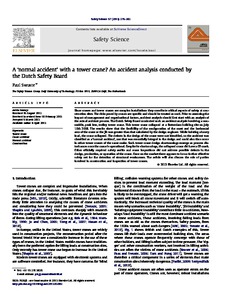A ‘normal accident' with a tower crane? An accident analysis conducted by the Dutch Safety Board

2013
57
276-282
analysis of accident causes ; construction sites ; cranes ; occupational accidents
Occupational accidents
http://dx.doi.org/10.1016/j.ssci.2013.03.002
English
Bibliogr.;Ill.
"Since cranes and tower cranes are complex installations they constitute critical aspects of safety at construction sites. The risks posed by cranes are specific and should be treated as such. Prior to assessing the impact of management and organizational factors, accident analysis should first start with an analysis of the actual accident process. The Dutch Safety Board conducted such an accident analysis involving a non-mobile, peak less, trolley tower crane. This tower crane collapsed at a Rotterdam building site on July 10th 2008. The results show that the flexibility of the configuration of the mast and the horizontal arm of the crane or the jib was greater than that calculated by the design engineer. While hoisting a heavy load, the crane collapsed. The defects in the design of the crane were not identified, so the accident was classified as a ‘normal accident', one that was essentially integral to the design and could also thus occur in other tower cranes of the same make. Such tower crane design shortcomings emerge as process disturbances once the crane is operational. Despite its shortcomings, the collapsed crane did have a CE mark. Other officially required safety audits and crane inspections did not address possible defects in the design, production, or operation of the crane. Once on the market there appears to be no further effective safety net for the detection of structural weaknesses. The article will also discuss the role of parties involved in construction and inspection of tower cranes."
Digital
The ETUI is co-funded by the European Union. Views and opinions expressed are however those of the author(s) only and do not necessarily reflect those of the European Union or the ETUI.